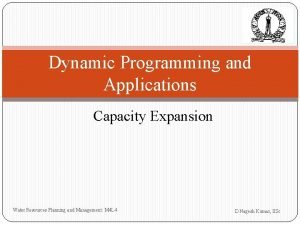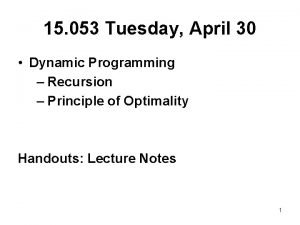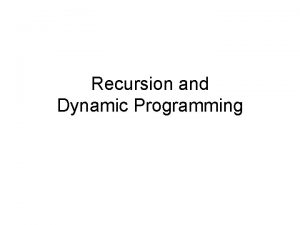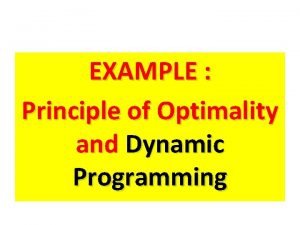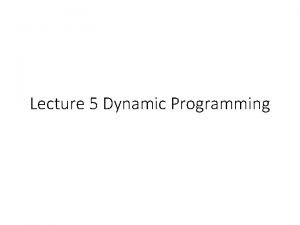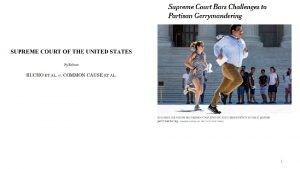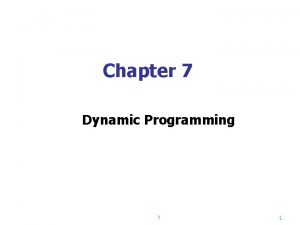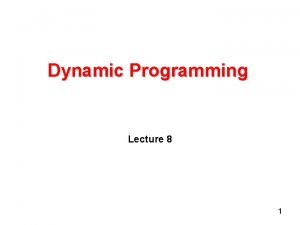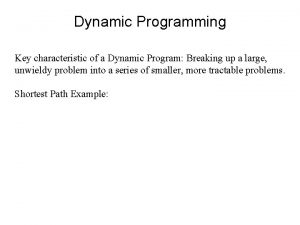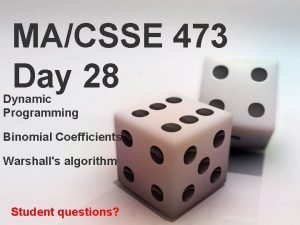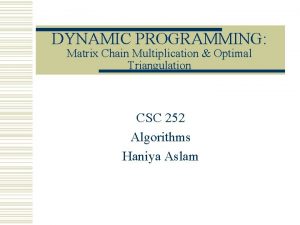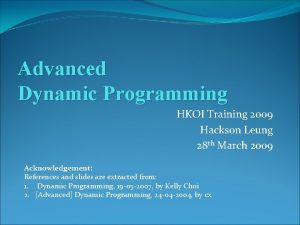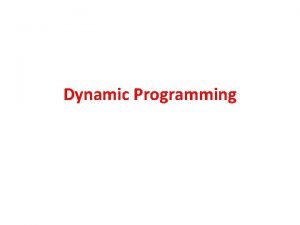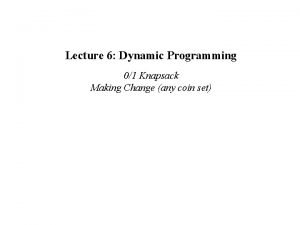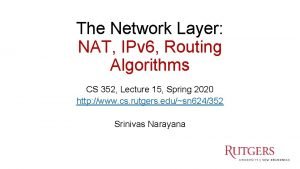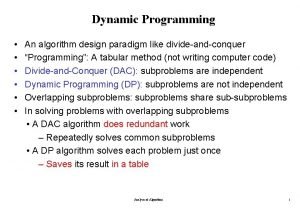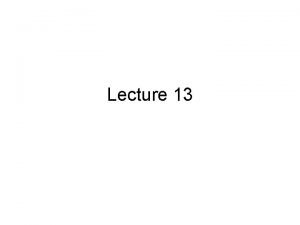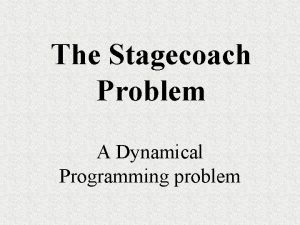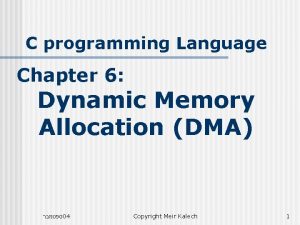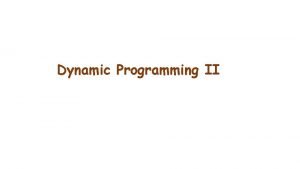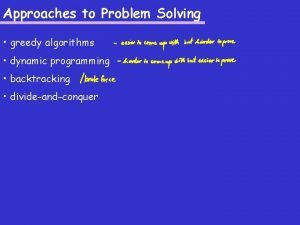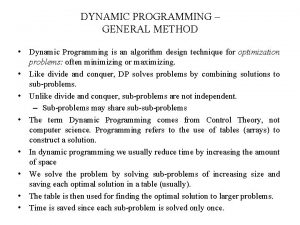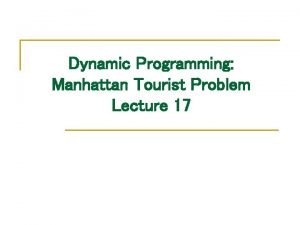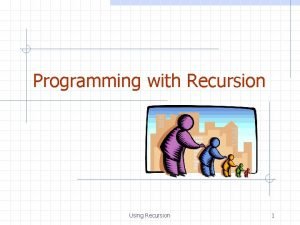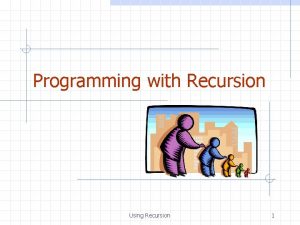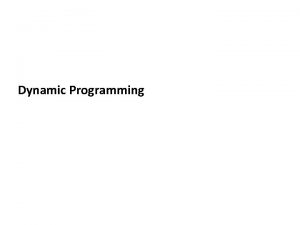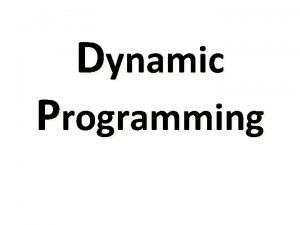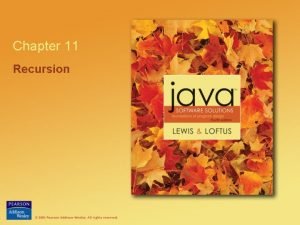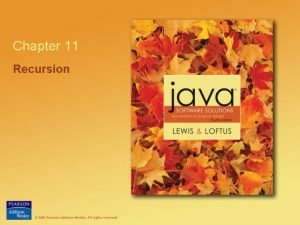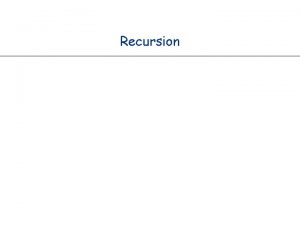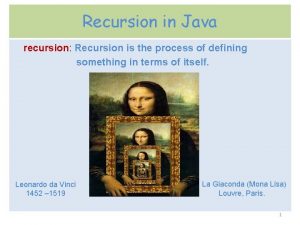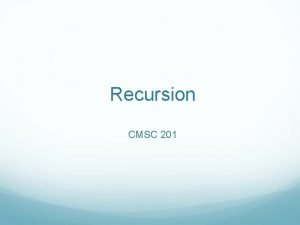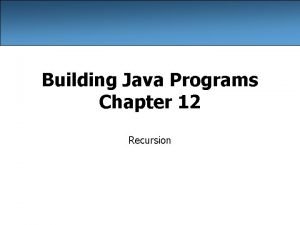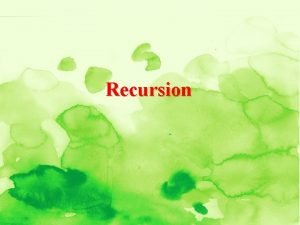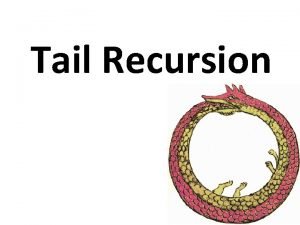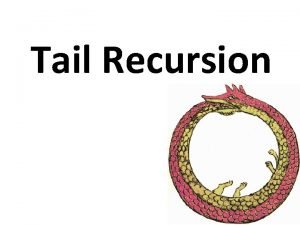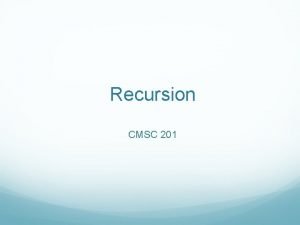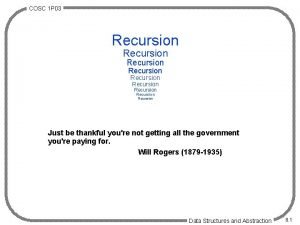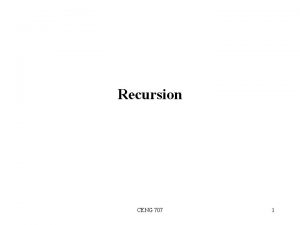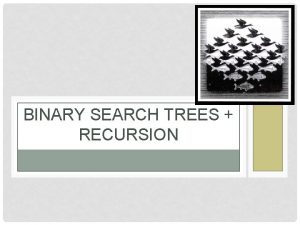15 053 Tuesday April 30 Dynamic Programming Recursion




























- Slides: 28

15. 053 Tuesday, April 30 • Dynamic Programming – Recursion – Principle of Optimality Handouts: Lecture Notes 1

Dynamic Programming • Transforms a complex optimization problem into a sequence of simpler ones. • Usually begins at the end and works backwards • Can handle a wide range of problems • Relies on recursion, and on the principle of optimality • Developed by Richard Bellman 2

Recursion example • There are 11 people in a room. How many ways can one select exactly 6 of them? • Let f(n, k) denote the number of subgroups of size k out of n people. We want f(11, 6) The number of subgroups containing “ 1” is f(10, 5). The number of subgroups not containing “ 1” is f(10, 6). 3

f(n, k) = f(n-1, k-1) + f(n-1, k) f(n, n)=f(n, 0)=1 4

Dynamic Programming Example • Suppose that there are 30 matches on a table, and the person who picks up the last match wins. At each alternating turn, my opponent or I can pick up 1, 2 or 3 matches. Assuming that I go first, how can I be sure of winning the game? • (Discuss with partner). 5

DP Example. • • • I win if there are 1, 2, or 3 matches Backing up one step, I lose if there are 4 matches. Backing up another step, I win if there are 5, 6, or 7 matches. Backing up another step, I lose if there are 8 matches. • Conclusion. I lose if there are 4 K matches. I win otherwise. 6

Determining the strategy using DP • n = number of matches left (n is the state/stage) • f(n) = 1 if you can force a win at n matches. f(n) = 0 otherwise f(n) = optimal value function. • At each state/stage you can make one of three decisions: take 1, 2 or 3 matches. • f(1) = f(2) = f(3) = 1 (boundary conditions) The recursion: • f(n) = 1 if f(n-1) = 0 or f(n-2) = 0 or f(n-3) = 0; f(n) = 0 otherwise. • Equivalently, f(n) = 1 – min (f(n-1), f(n-2), f(n-3)). 7

Running the Recursion 8

Similar, but more difficult example • Suppose that there are 50 matches on a table, and the person who picks up the last match wins. At each alternating turn, my opponent or I can pick up 1, 2 or 6 matches. Assuming that I go first, how can I be sure of winning the game? 9

Determining the strategy using DP • n = number of matches left (n is the state/stage) • g(n) = 1 if you can force a win at n matches. g(n) = 0 otherwise g(n) = optimal value function. At each state/stage you can make one of three decisions: take 1, 2 or 6 matches. • g(1) = g(2) = g(6) = 1 (boundary conditions) • g(3) = 0; g(4) = g(5) = 1. (why? ) The recursion: • g(n) = 1 if g(n-1) = 0 or g(n-2) = 0 or g(n-6) = 0; g(n) = 0 otherwise. • Equivalently, g(n) = 1 – min (g(n-1), g(n-2), g(n-6)). 10

Running the Recursion 11

The same table 12

Example from BH&M page 453 13

Solving the shortest path problem using recursion • For each square j, let f(j) be the shortest path starting at j and ending at the right hand side. • If j is a rightmost node, then f(j) is the cost of j. • j is the state/stage • f(j) is the optimal value function. 14

Example from BH&M page 453 15

The easy computations 16

Taking it to the second stage 17

Taking it to the third stage 18

Dynamic Programming in General • Break up a complex decision problem into a sequence of smaller decision subproblems. • Stages: one solves decision problems one “stage” at a time. Stages often can be thought of as “time” in most instances. – Not every DP has stages – The previous shortest path problem has 6 stages – The match problem does not have stages. 19

Dynamic Programming in General • States: The smaller decision subproblems are often expressed in a very compact manner. The description of the smaller subproblems is often referred to as the state. – match problem: “state” is the number of matches left • At each state-stage, there are one or more decisions. The DP recursion determines the best decision. – match problem: how many matches to remove – shortest path example: go right and up or else go down and right 20

Principle of Optimality • Any optimal policy has the property that whatever the current state and decision, the remaining decisions must constitute an optimal policy with regard to the state resulting from the current decision. (As formulated by Richard Bellman. ) • Whatever node j is selected, the remaining path from j to the end is the shortest path starting at j. 21

Optimal Capacity Expansion: What is the least cost way of building plants? Cost of $15 million in any year in which a plant is built. At most 3 plants a year can be built 22

Forwards recursion • Start with stage 1 and determine values for larger stages using recursion • In the match examples, determine f(n) from f(k) for k < n. 23

Backwards Recursion • Boundary conditions: optimum values for states at the last stage • Determine optimum values for other stages using backwards recursion 24

Determining state and stage • Stage: year Y • State: number of plants • f(j, Y) = optimum cost of capacity expansion starting with j plants at the end of year Y. • We want to compute f(0, 2002). • What is f(j, 2007) for different j? 25

Determining state and stage • Work with your partner to determine f(j, 2006) for each j. You may use the values for f(j, 2007). • If you complete this, compute f(j, 2005) for each j. • Then compute f(j, 2004) for each j. 26

Summary for Dynamic Programming • Recursion • Principle of optimality • states and stages and decisions useful in a wide range of situations – games – shortest paths – capacity expansion – more will be presented in next lecture. 27

Taking it to the final stages 28
 Dynamic programming recursion example
Dynamic programming recursion example Dynamic programming recursion example
Dynamic programming recursion example Recursion vs dynamic programming
Recursion vs dynamic programming To understand recursion you must understand recursion
To understand recursion you must understand recursion Greedy algorithm vs dynamic programming
Greedy algorithm vs dynamic programming Dynamic dynamic - bloom
Dynamic dynamic - bloom Principle of optimality in algorithm
Principle of optimality in algorithm A b a b c d e
A b a b c d e Gerrymandering dynamic programming
Gerrymandering dynamic programming Backward approach in multistage graph
Backward approach in multistage graph Dynamic programming history
Dynamic programming history Characteristics of dynamic programming
Characteristics of dynamic programming Binomial coefficient using dynamic programming
Binomial coefficient using dynamic programming Dynamic programming vs divide and conquer
Dynamic programming vs divide and conquer Advanced dynamic programming
Advanced dynamic programming Divide and conquer greedy algorithm
Divide and conquer greedy algorithm Binomial coefficient excel
Binomial coefficient excel Dynamic programming equation
Dynamic programming equation Algorithm design paradigm
Algorithm design paradigm Steps of dynamic programming
Steps of dynamic programming Stagecoach problem
Stagecoach problem Dma dynamic memory allocation
Dma dynamic memory allocation Matrix chain multiplication dynamic programming
Matrix chain multiplication dynamic programming Dynamic programming in excel
Dynamic programming in excel Dynamic programming
Dynamic programming General method of dynamic programming
General method of dynamic programming Manhattan tourist problem
Manhattan tourist problem Dynamic programming tabulation
Dynamic programming tabulation Dynamic problem
Dynamic problem
